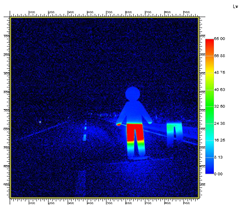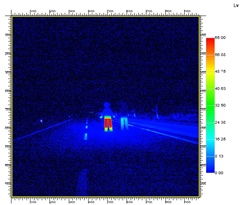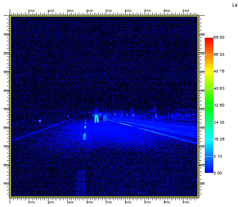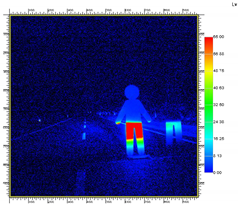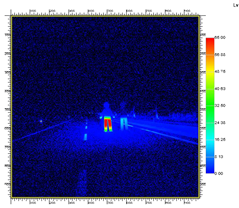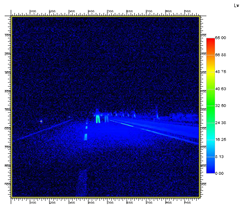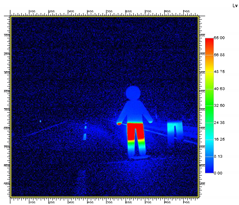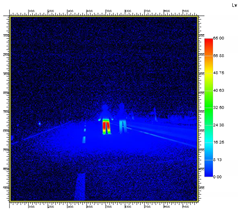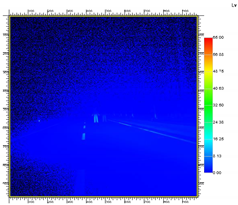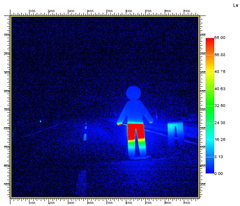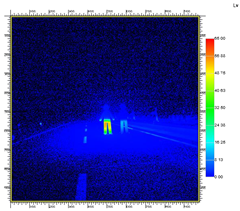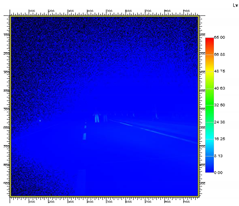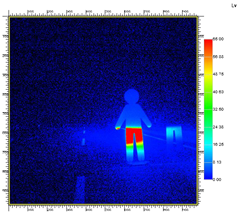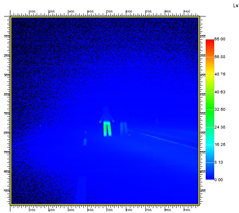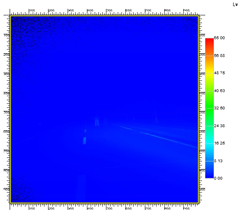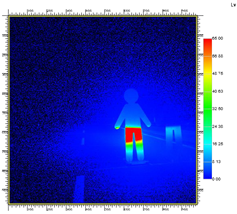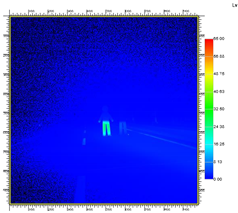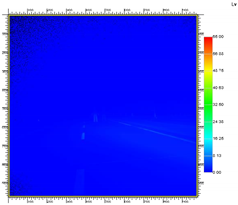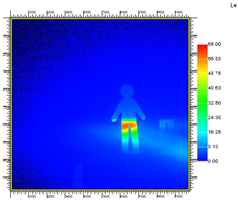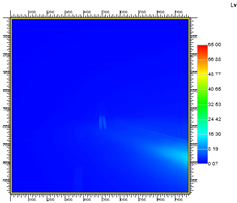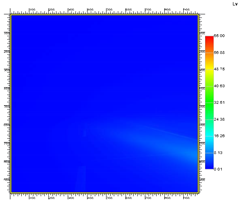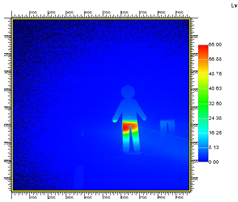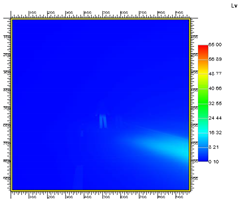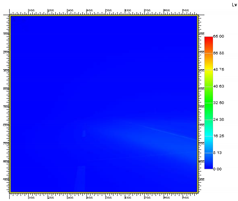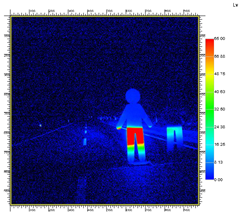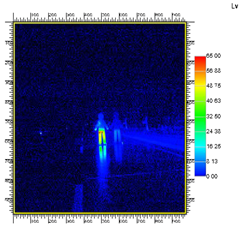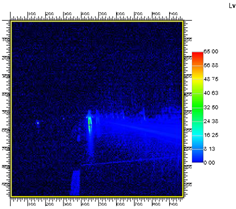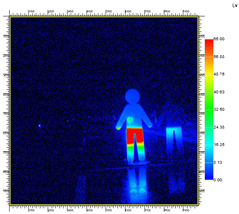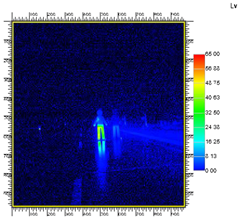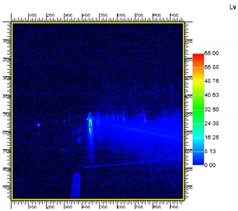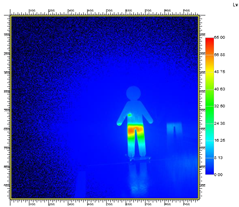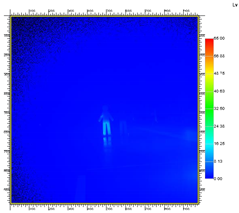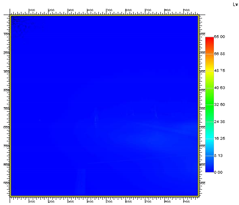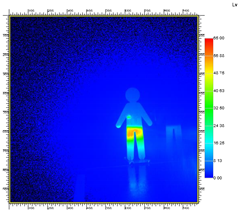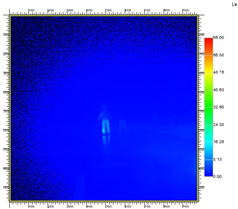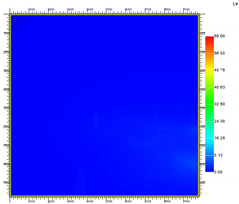Abstract
This study evaluated a method of applying color temperature convertible headlamps to improve driving safety in adverse weather conditions such as fog and rain during night driving. The concept of color temperature convertible headlamps is to improve the driver’s visibility by driving with a color temperature of 6000 K on a clear night and switching to a color temperature of 3000 K with better light transmittance at night in adverse weather. Through this study, a method for evaluating the night visibility related to such color temperature convertible headlamps under bad weather at night was suggested. To this end, a method of using a facility that can implement weather conditions such as fog and rain was proposed, and evaluation conditions according to the climatic conditions and the distance of pedestrian targets were set and actual tests were conducted.
1. Introduction
Driving at night in adverse weather conditions can be a threat to safe driving by reducing the driver’s forward visibility []. The mesopic and glaring conditions of the night driving environment, especially due to age-related deterioration of vision, make night driving more difficult for the elderly []. Since August 2017, Korea has become an aging society in which the proportion of the population aged 65 and over accounts for more than 14% of the total population [], and the proportion of elderly drivers is increasing every year []. As the number of older drivers increases, the incidence of traffic accidents among older drivers is also increasing [,]. According to statistics from the Road Traffic Authority, as of 2016, the total number of traffic accidents in Korea decreased by 4.8% compared to the previous year, but the number of traffic accidents involving elderly drivers increased by 5.9% []. The number of traffic accidents involving elderly drivers is increasing every year due to deterioration of cognitive ability while driving and deterioration of driving ability due to geriatric diseases []. In this regard, there is a case in which a headlamp was developed and evaluated to improve the visibility of the elderly in consideration of the glare and sensitivity characteristics of the elderly []. Considering the traffic environment in which the proportion of elderly drivers is increasing, the development of technology that enables safe driving by increasing driver visibility and securing reaction time will be helpful not only to elderly drivers but also to general drivers []. In addition, it can be expected that the overall accident rate will be reduced, and thus, direct and indirect reductions in social costs caused by traffic accidents are expected [].
If the luminance of the target object can be made relatively higher than the background luminance in bad weather conditions such as fog or rain, the likelihood of recognizing the target object at a distance greater than the vehicle stopping distance will increase []. In addition, there is a case in which the visibility can be improved in bad weather compared to the color temperature of about 3000 K and the color temperature of 6000 K []. The visibility performance of headlamps is generally evaluated based on the luminous intensity or illuminance of the headlamps []. Illuminance is evaluated by directly measuring the light intensity of the light source, and luminance measures the intensity of light emitted from the light source that is reflected on a specific incident surface and reaches the human eye []. Therefore, rather than the illuminance, which is the amount of light from the headlamp itself, the road surface luminance, which is the amount of light that is reflected from the road surface and enters the driver’s eyes, and the luminance that enters the driver’s eyes after being reflected by obstacles on the road are more suitable indicators for the evaluation of visibility related to the headlamps [].
From the perspective of automobiles, in the case of studies related to night visibility in bad weather conditions, there are studies on subjective and objective evaluation methods and research cases for improving visibility [,,,,,,,,]. In the case of studies on visibility evaluation methods, there is a study on the performance of LED streetlights with different color temperatures [], and there is a case where the visual performance with different CCTs (correlated color temperatures) in mesopic conditions is evaluated []. In some cases, subjective evaluations were conducted through participants for each different CCT [], and in other cases, LED (light-emitting diode) headlamps were evaluated through objective and subjective methods []. Among the interesting studies related to the objective visibility evaluation method, there are cases where the contrast between the road surface and lane markings was measured using a mobile retroreflectometer mounted on a vehicle [,]. These two studies were limited to the contrast between the lane markings and the road surface, not the study on the contrast between the pedestrian and the road surface in bad weather conditions. In adverse weather conditions, especially in fog and rain conditions, the backscattering effect can cause deterioration of driver visibility []. In this regard, interesting study related to objective visibility evaluation is a method of estimating visibility in fog conditions at night by detecting the halo of streetlamps and the backscattering veil of headlights using a camera and image processing technique []. In the case of a method to improve visibility, there are studies that use a camera and image processing technique to detect snow and rain particles in real time and appropriately control the light source accordingly to reduce the backscattering effect caused by headlights to improve visibility []. In the case of the above two studies, cameras and image processing techniques were used for objective evaluation, but objects such as pedestrians were not included in the study, and the effect of the color temperature change of the headlamp was not considered. In addition to the research cases mentioned above on the effect of visual light, such as the effect of color temperature on visibility, there are cases where the effect of non-visual light, such as the melanopic effect of bluish light on human awakening and alertness, has been studied [,,].
In this paper, we would like to introduce the contents of our research limited to the effect of visual light. In particular, we proposed a visibility evaluation method related to color temperature convertible headlamps, and based on this, we tried to check whether color temperature conversion helps improve visibility in bad weather. To this end, we propose a method to quantitatively evaluate visibility by measuring only the luminance of pedestrian targets and road surfaces in a facility that can artificially realize fog and rain.
1.1. Visiblity
At night, the driver should be able to determine the presence of obstacles in front from an appropriate distance []. In order to make the driver aware of obstacles ahead when driving at night, the luminance contrast between the obstacle and the corresponding road surface as the background must be greater than the critical luminance contrast, which is the boundary for identifying obstacles []. The critical luminance contrast is affected by the adaptation luminance, the size of the critical obstacle, the contrast polarity of the critical obstacle, the observation time, and the age of the driver [,]. In this regard, a model for quantitatively measuring the visibility level was proposed [].
In this study, the target luminance was measured at 3000 K and 6000 K without using a complex model including the driver’s age factor, and the contrast value was calculated for comparative evaluation. This is because it is better to study the relative visibility improvement effect of 3000 K compared to 6000 K in bad weather conditions.
To improve the visibility of obstacles when driving at night, the luminance contrast between the obstacle and the road surface should be high [], and the Weber contrast equation for measuring this can be expressed as (1) [].
In this study, was defined as the luminance of the pedestrian target and was defined as the luminance of the road surface. If the luminance value of the pedestrian object is higher than the luminance value of the road surface, the contrast is high, and if the contrast is high, it can be considered that the visibility is also high [].
1.2. Adverse Weather
For safe driving, the driver should be able to secure the minimum stopping distance to avoid or stop when an obstacle appears in front and the time to respond. However, when fog, rain, or heavy snow occurs, the driver’s visibility decreases, and in the case of an obstacle or unexpected situation in front, the time and distance that the driver can respond to is reduced, which can lead to a dangerous situation [].
In general, such bad weather conditions may include fog, rain, snow, strong winds, etc., but in this study, considering the repeatability of the test conditions, it was decided to limit the conditions to fog and rain conditions. In addition, the climatic conditions were determined according to the degree of fog and rain.
1.3. Color Temperature Convertible Headlamps
Color temperature convertible/switchable type headlamps are generally driven by using white lamps with a color temperature of about 6000 K and are converted to yellow lamps with a color temperature of about 3000 K in bad weather such as fog or rain. In addition, it may refer to color temperature variable headlamps in which the color temperature of the headlamps is varied from, for example, 3000 K to 6000 K to improve visibility of the driver in real-time changing weather or driving environment.
As shown in Figure 1, the headlamps in this study were for Kia Carnival (2018 model year) vehicles, and color temperature conversion (3000 K, 6000 K) type headlamps made separately for research purposes were used instead of the headlamps for mass production vehicles. The implemented headlamps combine the light of the warm white LED chips and the cool white LED chips through the reflector and lens to achieve 3000 K and 6000 K. Figure 2 indirectly shows the spectral characteristics of 3000 K and 6000 K for headlights reflected by pedestrian targets under clear conditions using the spectral camera (ImSpector V10E, Specim, Oulu, Finland).

Figure 1.
Color temperature convertible headlamps in operation: (a) Headlamp lighting in operation in foggy conditions; (b) 3000 K lighting; (c) 6000 K lighting.
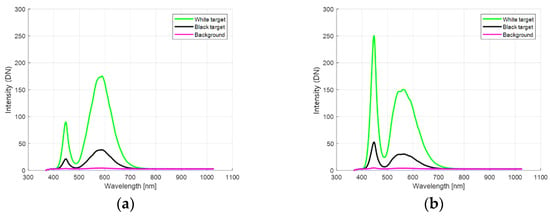
Figure 2.
Headlamp light output characteristics identified indirectly by profile raw data from the spectral camera for headlamp light reflected by pedestrian targets in clear condition; (a) 3000 K lighting; (b) 6000 K lighting.
2. Evaluation Method
2.1. Test Concept
Figure 3 shows the concept of the test environment for convertible color temperature headlamps. It is a concept to measure the luminance of pedestrian targets by changing the climatic conditions, the color temperature of the headlamps, and the location of the pedestrian targets for each test condition.
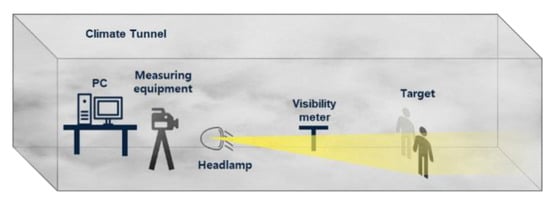
Figure 3.
Test environment concept.
2.2. Overal Test Procedure
As shown in Figure 4, the overall test procedure is: (1) the installation of measuring devices such as luminance meter and visibility meter, installation of headlamps, (2) setting of climatic conditions, setting of pedestrian targets according to the distance conditions between vehicle and pedestrian, and (3) measurement of luminance of pedestrian targets and road.
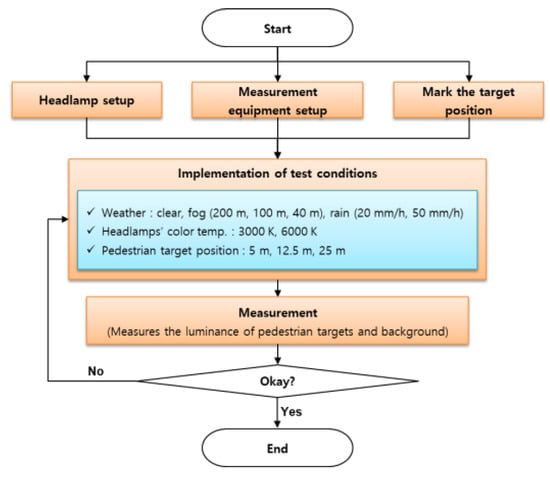
Figure 4.
Test procedure for convertible color temperature headlamps.
2.3. Test Conditions
2.3.1. Weather Conditions
For the test, a method of utilizing a tunnel with a scale of more than three lanes in width and 100 m in length that can realize fog and rainfall conditions was defined. This is because, when testing in a narrow space, the light irradiated by the headlamps is reflected due to the structure and material of the left and right wall surfaces and is irradiated to the pedestrian target again, which may cause difficulty in accurate measurement.
As shown in Table 1, the clear condition means that the climatic condition is not fulfilled, and the visibility is 2 km or more. Visibility distances in fog conditions were set to 40 m, 100 m, and 200 m. If the visibility distance is 40 m, it corresponds to dense fog, if it is 100 m, it corresponds to thick fog, and if it is 200 m or more, it corresponds to fog []. Rainfall conditions were defined as 20 mm/h and 50 mm/h. Rainfall of 20 mm/h corresponds to heavy rain, and 50 mm/h corresponds to violet rain [].

Table 1.
Weather conditions for the test.
It should be noted here that there is no weather standard for testing color temperature variable headlamps. In order to establish the above criteria, several studies were reviewed and discussions with relevant parties and a number of trials were required. In addition, it is considered necessary to define test conditions in consideration of the characteristic weather that occurs frequently in each country.
2.3.2. Pedestrian Targets
Regarding pedestrian targets, taking the EuroNCAP protocol document for emergency braking tests as an example, the specifications of pedestrian targets in consideration of collisions with cars are presented. Such targets exist, for example, pedestrians and cyclists, and the shape and material were manufactured considering the viewpoint of various automotive ADAS (advanced driver assistant system) sensors, including radar cross-section characteristics [].
In the case of pedestrian targets, there is no standardized pedestrian target that is widely used in the industry from the viewpoint of automotive lighting, so in this study, it was made and used from the viewpoint of a reflector by a headlamp light source. As shown in Figure 5, for this purpose, only white/black targets made of metal plates were used in this test, but various colors, various sizes, and various materials can be considered.
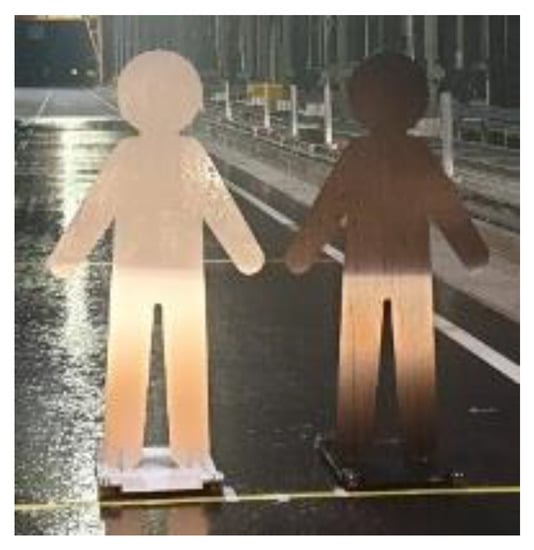
Figure 5.
Pedestrian type reflectors as pedestrian targets: Pedestrian target design (height 175 cm, width 92 cm, with four wheels attached below for convenience of movement.
2.3.3. Target Position
Figure 6 shows the distance conditions between the vehicle and the pedestrian target were defined as 5 m, 12.5 m, and 25 m. Except for the minimum distance of 5 m for measurement, the remaining distance conditions were considered to require a time of at least 1.5 s for the driver to avoid collision with the pedestrian target []. Here, Time to Collision (TTC) should be considered, which is often a very important variable in relation to FCW (forward collision warning) or CAS (collision avoidance system) [,].

Figure 6.
Pedestrian target position.
Table 2 shows a summary of the positions of pedestrian targets. In the case of 25 m, when driving at 60 km/h (the speed limit at the time of the test, which has been changed to 50 km/h after April 2021 in Korea), which was the speed limit on roads except for automobile-only roads in Korean cities, the TTC (time to collision) is the driving distance considering 1.5 s, and 12.5 m is the driving distance considering the TTC when driving at 30 km/h, which is 1/2 of the maximum speed, in fog with a visibility of 100 m or less.

Table 2.
Description of pedestrian target positions.
2.4. Measurement
As shown in Figure 7, the tunnel of the SOC Evaluation Research Center (located in Yeoncheon-gun, Gyeonggi-do, Korea), which can realize fog and rainfall, and has a sufficient scale, was used as a facility for realizing bad weather. This facility can simulate fog and rain conditions in the form of a tunnel with a length of 200 m, a width of 32.8 m, and a maximum height of 16.2 m. In the case of the fog device used in this study, it is installed on both sides of the road at 10 m intervals in the 200 m tunnel, and uniform fog density can be realized using fog oil and a diffusion fan. Rain nozzles are installed at 10 m intervals in the 200 m tunnel section and the maximum rainfall is 100 mm/h.

Figure 7.
Implementation of fog and rain conditions in the test facility: (a) Inside view of the climatic tunnel; (b) fog generator operation inside the tunnel; (c) rainfall by rain nozzles inside the tunnel.
Figure 8 shows the setup for the measurement. Two movable pedestrian targets (one white and the other black) were used for the test, and the color temperature convertible headlamps were fixed to face the pedestrian targets. In the case of measuring equipment, a luminance meter (CA-2000, Konica Minolta, Tokyo, Japan) for measuring the luminance of a pedestrian target and a visibility sensor (VPF-710, Biral, Bristol, UK) were installed to measure the visibility distance according to weather conditions. The luminance meter was set up in consideration of the driver’s eye level, and the position of the visibility sensor was placed outside the irradiation range of the headlight. This is to ensure that the near-infrared rays that may be included in the headlights do not affect the visibility sensor.
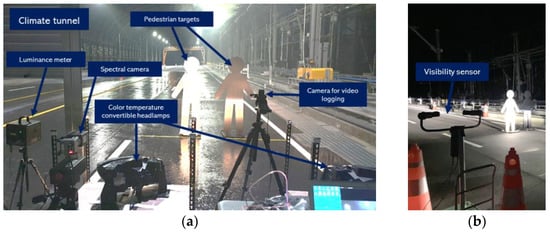
Figure 8.
Measurement setup for the test: (a) Installation of measuring devices and pedestrian targets in the climate tunnel; (b) visibility sensor installed on the side avoiding the irradiation range of the headlight.
When setting the climatic conditions, the luminance value of the reference light source was referred to in consideration of the error of the visibility system, and the test environment conditions were followed. In addition, to secure the objectivity of the luminance value, the measurement was carried out after 30 min with the reference light source turned on in consideration of the preheating and light quantity stabilization time of the reference light source. In the case of rain, measurements were started when the road surface was sufficiently wet after spraying for more than 10 min under rain conditions.
The brightness condition of night external conditions was set to 1 lux or less by referring to Euro NCAP AEB night test conditions []. The test was conducted under 36 conditions as shown in Table 3, and the climatic conditions were clear, fog, and rain in this order.

Table 3.
Test cases considering weather conditions.
Figure 9 shows photos taken during actual measurement under clear, fog, and rain conditions, respectively, at 3000 K and target distance of 12.5 m. Figure 10 shows the case where only the color temperature is changed to 6000 K under the same conditions as in Figure 9.
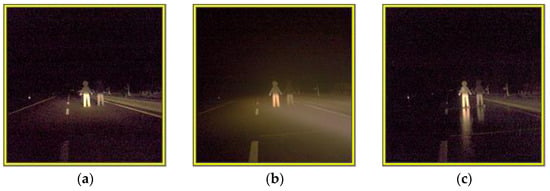
Figure 9.
Examples of measurements in conditions of pedestrian target distance of 12.5 m and color temperature of 3000 K: (a) Clear condition; (b) fog condition with a visibility of 100 m; (c) rain condition with a rainfall of 20 mm/h.
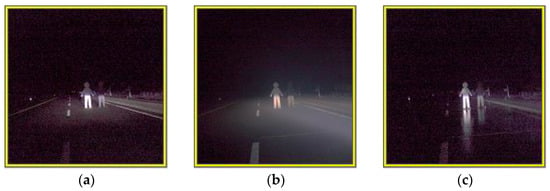
Figure 10.
Examples of measurements in conditions of pedestrian target distance of 12.5 m and color temperature of 6000 K: (a) Clear condition; (b) fog condition with a visibility of 100 m; (c) rain condition with a rainfall of 20 mm/h.
2.5. Data Analysis
In general, in the case of a test on a night road, visibility is evaluated based on the contrast between the luminance of the obstacle and the road surface []. Since this test was conducted on the night road in the facility, the luminance of the pedestrian target (obstacle) and the background (road surface) were set as ROIs (regions of interest) [,]. The ROI of the target area was the leg part of the pedestrian target under the cut-off line of the headlight, the background ROI was the road surface next to the target, and the size of the background ROI was the same as the size of the target ROI (Figure 11).
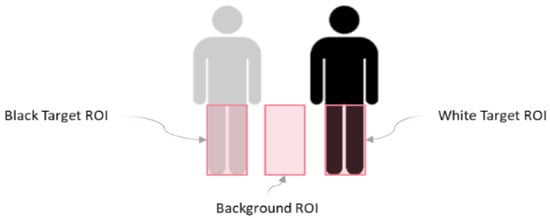
Figure 11.
The concept of setting ROIs for analysis.
It was possible to obtain an average luminance value for each ROI in the pedestrian target and the background (Appendix A). The luminance data acquired by the luminance meter was calculated for contrast after ROIs were set so that the visibility was compared and evaluated through luminance and contrast under the conditions of 3000 K and 6000 K of color temperature.
3. Results
3.1. Clear Condition
Table 4 shows the luminance values under the clear condition. Table 5 provides the average contrast values of ROIs in clear conditions.

Table 4.
Comparison of luminance by target distance and color temperature (clear condition).

Table 5.
Average contrast of ROI in clear conditions.
3.2. Fog Conditions
Table 6, Table 7 and Table 8 show luminance values under conditions of 200 m, 100 m, and 40 m of fog. Table 9 provides the average contrast values of the pedestrian target against the background for each detailed fog condition.

Table 6.
Comparison of luminance by target distance and color temperature (fog 200 m).

Table 7.
Comparison of luminance by target distance and color temperature (fog 100 m).

Table 8.
Comparison of luminance by target distance and color temperature (fog 40 m).

Table 9.
Average contrast of ROIs in fog conditions.
As can be seen from Table 10, based on Weber Contrast, the 3000 K color temperature compared to the 6000 K color temperature at 200 m of visibility showed a contrast difference of 3.7% to 34.84% for the white pedestrian target, and −0.96% to 43.86% for the black pedestrian target. At 5 m of the black pedestrian target, 43.86%, the maximum contrast, appeared. Under the condition of visibility of 200 m, in case of the 3000 K color temperature compared to the 6000 K color temperature showed a difference of 3.7% to 34.84% of contrast based on the white pedestrian target and showed a difference of −0.96% to 43.86% of the contrast with the black pedestrian target. The maximum contrast ratio of 43.86% was found at 5 m of the pedestrian target.

Table 10.
3000 K contrast ratio compared to 6000 K in fog conditions.
In the case of 100 m visibility, in case of the 3000 K color temperature compared to the 6000 K color temperature showed a contrast difference of −20.55% to 106.21% for the white pedestrian target, and −30.02% to 313.25% for the black pedestrian target. It showed 313.25%, which is the maximum contrast, at the 5 m point of the black pedestrian target.
3.3. Rain Conditions
Table 11 and Table 12 show the luminance values under the conditions of rainfall of 20 mm/h and 50 mm/h. Table 13 provides the average contrast values of the pedestrian-targets against the background for each detailed condition under rainfall conditions.

Table 11.
Comparison of luminance by target distance and color temperature (rain 20 mm/h).

Table 12.
Comparison of luminance by target distance and color temperature (rain 50 mm/h).

Table 13.
Average contrast of ROI in rain conditions.
As shown in Table 14, when calculated based on Weber Contrast, the 3000 K color temperature compared to the 6000 K color temperature under the 20 mm/h rainfall condition showed a contrast difference of −3.33% to 13.05% based on the white pedestrian target. In terms of the black pedestrian target, the contrast difference was −6.80% to 15.09%, and the maximum contrast was 15.09% at 12.5 m of the black pedestrian target.

Table 14.
3000 K contrast ratio compared to 6000 K in rain conditions.
Under the 50 mm/h rainfall conditions, the 3000 K color temperature compared to the 6000 K color temperature showed a difference of −27.71% to 22.15% for the white pedestrian target, and −12.33% to 37.58% for the black pedestrian target. The maximum contrast at 5 m of the pedestrian target was 37.58%.
4. Discussion
Through the method proposed in this study, contrast values were compared according to the color temperature of 3000 K and 6000 K for pedestrian targets under bad weather conditions at night. The color temperature convertible headlamps were tested by changing the weather conditions and the position of pedestrian targets. The luminance and contrast values were compared for each test condition, and the average luminance values of the ROIs and the contrast values for the color temperature of 6000 K versus 3000 K were compared.
4.1. Effect of 3000 K in Adverse Weather Conditions
According to Table 15, 3000 K of the white target in eight test cases and the black target in 10 test cases showed a higher contrast ratio than 6000 K, except for the clear condition. This means that the contrast is often higher at 3000 K than at 6000 K in the bad weather conditions used in this test. In particular, it is often higher in fog conditions than in rainfall conditions, and among fog conditions, it is often higher in fog with a visibility distance of 200 m than in dense fog or thick fog. This could mean that 3000 K can be better than 6000 K for recognizing forward pedestrian targets in light fog with a visibility of 200 m.

Table 15.
The results of comparing the contrast for each test case.
As mentioned above, it was found that in some bad weather conditions at night, the color temperature of 3000 K of the headlamps is more effective in securing visibility than when it is 6000 K. However, it was found that the effect of 3000 K color temperature was negligible under dense fog, especially under the condition of a target distance of 5 m with a visibility of 40 m. This seems to be related to the fact that the average luminance value of the background ROI increases and the contrast decreases due to the backscattering of light due to the dense fog near the headlamp.
4.2. Limitations of This Study and Further Studies
In this study, only the contrast values were compared by measuring the luminance values for pedestrian targets at 3000 K and 6000 K, and in some bad weather test conditions, the contrast was higher at 3000 K than at 6000 K. In this case, it is thought that a comparative experiment is necessary to confirm whether the pedestrian’s target is more visible at 3000 K than at 6000 K even to the human eye.
When conducting an experiment through the participation of a large number of participants, it is necessary to organize various participants in consideration of the appropriate number of participants, gender, age, etc. In particular, it is necessary to study how the color temperature variable headlamp affects the visibility of the elderly. In this case, it may be necessary to consider the characteristics of the eyes according to the age of the person. In addition, it appears that it is necessary to consider not only visual effects but also non-visual effects when conducting experiments with participants. This is to consider not only the CCT variable from the viewpoint of improving visibility, but also the effect of a characteristic of a specific color temperature on a person (driver). For example, if bluish color temperature improves driver alertness when driving at night to prevent drowsy driving and helps drivers make good decisions in emergency situations, then it can also help drive safely.
In this case, the effect of metamerism according to the characteristics of the light source and the reflector can also be considered. In the case of light sources, the same CCT can be implemented in various ways, and metamerism can be affected accordingly. In particular, the use of a spectral camera can be a method to analyze the characteristics of light sources by wavelength band, and there is a case of using a hyperspectral camera in the image recognition field to distinguish between the street lights and the headlights of vehicles [].
Research is needed not only from the point of view of the human eye in bad weather at night, but also from the point of view for improving the recognition performance of sensors for automobiles. In particular, it is necessary to study technologies and evaluation methods for overcoming bad weather from the standpoint of autonomous driving systems. Of course, it is also necessary to study backscattering in dense fog conditions. In this regard, as mentioned in the introduction section, several studies have been conducted [,,]. In view of this, it is expected that progress will be ultimately made through sensor-integrated headlamps with respect to issues related to backscattering. To this end, a sensor-integrated headlamp in which a lidar, camera, or radar is integrated into a headlamp assembly is being developed [,], and it is considered that an evaluation method is needed from the viewpoint of human visibility and the recognition performance of the systems. Through this, for safe driving even in bad weather at night, it is necessary to provide improved visibility to the driver and the best recognition performance for the autonomous driving system.
5. Conclusions
This study proposed a method for evaluating visibility in bad weather at night related to color temperature convertible headlamps. In particular, the method proposed in this study can be said to be a method of relative comparison of visibility by comparing the contrast ratio according to the color temperature of 3000 K and 6000 K using pedestrian targets in a facility that can realize bad weather conditions at night. Through this, weather conditions such as fog and rain and the distance of the pedestrian target were suggested and actual tests could be carried out.
The method presented in this study is a comparative evaluation method that can be performed simply if there is a facility for implementing bad weather, but it can be said that a complementary study through the participation of various users is necessary. In particular, in order to supplement this study, research is needed from the perspective of user acceptance through various participants including the elderly, and studies on the effects of non-visual light such as the effect of melanopic from the perspective of driving safety are also needed.
In addition, it is necessary to study not only the improvement of human visibility in bad weather conditions at night, but also the improvement of sensing performance from the perspective of the autonomous driving system. In this regard, it is considered that research on the implementation of sensor-integrated headlamps and the development of evaluation methods for them is necessary.
Author Contributions
Conceptualization, H.-J.K.; methodology, H.-J.K.; formal analysis, H.-J.K.; investigation, H.-J.K.; writing—original draft preparation, H.-J.K.; writing—review and editing, S.-J.K.; visualization, H.-J.K.; supervision, S.-J.K.; project administration, S.-J.K. Both authors have read and agreed to the published version of the manuscript.
Funding
This study was supported by the Korea Institute for Advancement of Technology (KIAT) and funded by the Ministry of Trade, Industry and Energy (MOTIE) of the Korean government (No. P0013840).
Data Availability Statement
Data is contained within the article.
Conflicts of Interest
The authors declare no conflict of interest.
Appendix A

Table A1.
Average luminance of ROI in clear conditions (cd/m2).
Table A1.
Average luminance of ROI in clear conditions (cd/m2).
| Weather Condition | Target Position | Color Temperature | Average Luminance of ROIs (cd/m2) | ||
|---|---|---|---|---|---|
| White Target | Black Target | Background | |||
| Clear | 5 m | 3000 K | 59.92 | 6.42 | 1.2 |
| 6000 K | 58.25 | 5.59 | 1.19 | ||
| 12.5 m | 3000 K | 40.81 | 6.26 | 1.07 | |
| 6000 K | 36.18 | 5.81 | 1.03 | ||
| 25 m | 3000 K | 13.5 | 4.09 | 0.48 | |
| 6000 K | 12.83 | 4.07 | 0.49 | ||

Table A2.
Average luminance of ROIs in fog conditions (cd/m2).
Table A2.
Average luminance of ROIs in fog conditions (cd/m2).
| Weather Condition | Target Position | Color Temperature | Average Luminance of ROIs (cd/m2) | ||
|---|---|---|---|---|---|
| White Target | Black Target | Background | |||
| Fog 200 m | 5 m | 3000 K | 56.49 | 4.81 | 1.21 |
| 6000 K | 53.89 | 4.05 | 1.32 | ||
| 12.5 m | 3000 K | 33.16 | 5.53 | 1.04 | |
| 6000 K | 27.49 | 5.04 | 1.15 | ||
| 25 m | 3000 K | 5.03 | 1.55 | 0.52 | |
| 6000 K | 4.12 | 1.32 | 0.44 | ||
| Fog 100 m | 5 m | 3000 K | 40.05 | 3.74 | 1.78 |
| 6000 K | 36.45 | 4.04 | 3.19 | ||
| 12.5 m | 3000 K | 13.94 | 3.04 | 1.57 | |
| 6000 K | 12.85 | 2.96 | 1.54 | ||
| 25 m | 3000 K | 2.01 | 1.03 | 0.74 | |
| 6000 K | 1.58 | 0.78 | 0.5 | ||
| Fog 40 m | 5 m | 3000 K | 22 | 7.21 | 6.94 |
| 6000 K | 21.19 | 4.13 | 3.69 | ||
| 12.5 m | 3000 K | 3.55 | 2.52 | 2.29 | |
| 6000 K | 3.74 | 2.09 | 1.73 | ||
| 25 m | 3000 K | 0.82 | 0.92 | 0.86 | |
| 6000 K | 0.61 | 0.69 | 0.65 | ||

Table A3.
Average luminance of ROI in rain conditions (cd/m2).
Table A3.
Average luminance of ROI in rain conditions (cd/m2).
| Weather Condition | Target Position | Color Temperature | Average Luminance of ROIs (cd/m2) | ||
|---|---|---|---|---|---|
| White Target | Black Target | Background | |||
| Rain 20 mm/h | 5 m | 3000 K | 47.15 | 5.09 | 0.91 |
| 6000 K | 46.6 | 4.56 | 0.87 | ||
| 12.5 m | 3000 K | 29.51 | 3.54 | 0.49 | |
| 6000 K | 26.16 | 3.14 | 0.49 | ||
| 25 m | 3000 K | 15.18 | 1.78 | 0.26 | |
| 6000 K | 13.28 | 1.6 | 0.22 | ||
| Rain 50 mm/h | 5 m | 3000 K | 21.52 | 3.9 | 2.94 |
| 6000 K | 20.81 | 3.91 | 3.16 | ||
| 12.5 m | 3000 K | 6.46 | 1.77 | 1.28 | |
| 6000 K | 5.65 | 1.8 | 1.31 | ||
| 25 m | 3000 K | 1.2 | 0.79 | 0.73 | |
| 6000 K | 1.21 | 0.7 | 0.64 | ||
References
- Kim, J.; Seong, R.; Koo, J.; Yoo, K.; Kim, Y.; Hwang, D.; Kim, D.; Park, H. Characteristic Analysis of Traffic Accidents in Severely Injury; Road Traffic Authority: Gangwon-do, Korea, 2019. [Google Scholar]
- Janessa, A.; Alex, A.; Joanne, M. Nighttime Driving in Older Adults: Effects of Glare and Association with Mesopic Visual Function. Investig. Ophthalmol. Vis. Sci. 2017, 58, 2796–2803. [Google Scholar] [CrossRef] [Green Version]
- Bae, M.; Yoo, K. An Empirical Study on Traffic Safety Education and Driving Behavior of Elderly Driver: Adjustment effect of driving confidence. J. Converg. Soc. Public Policy 2019, 13, 220–246. [Google Scholar] [CrossRef]
- Lee, W.; Kim, K.; Oh, J. A Study on the Major Factor of High-Risk Driver Groups’ Accidents: Focusing on Elderly Drivers; Road Traffic Authority: Gangwon-do, Korea, 2015; Available online: https://www.koroad.or.kr/cmm/fms/formFileDown.do?file_name=Fid2502 (accessed on 23 August 2021).
- Hong, S.; Park, W. The Accident and Injury Characteristics of Elderly Drivers on Lateral Impact. Trans. KSAE 2010, 18, 104–113. Available online: https://www.koreascience.or.kr/article/JAKO201020733096881.pdf (accessed on 23 August 2021).
- Kim, Y.; Lee, S.; Lee, E.; Jeon, K.; Yoo, K.; Kim, Y.; Hwang, D.; Park, H.; Park, S. Statistical Analysis of Traffic Accidents in 2017 (Statistics 2016); Road Traffic Authority: Gangwon-do, Korea, 2017. [Google Scholar]
- Kang, B.-D.; Kim, H.-G. Evaluation of Glare and Forward Visibility of Headlamp for Elder Friendly Vehicle. J. Korean Inst. Illum. Electr. Install. Eng. 2011, 25, 1–6. [Google Scholar] [CrossRef]
- Cho, W. Appropriateness Assessment of Illuminance-Based Evaluation Method in Automotive Headlight Visibility Perfor-mance. Int. J. Highw. Eng. 2017, 19, 165–173. [Google Scholar] [CrossRef]
- Jin, H.; Jin, S.; Chen, L.; Cen, S.; Yuan, K. Research on the Lighting Performance of LED Street Lights With Different Color Temperatures. IEEE Photon. J. 2015, 7, 1–9. [Google Scholar] [CrossRef]
- Tu, Q.; Li, F.; Zhou, T. Evaluating Visual Performance of Different CCT White LEDs under Mesopic Vision; SAE World Congress: Detroit, MI, USA, 2006. [Google Scholar] [CrossRef]
- Kim, H.; Kim, Y.; Choi, A. A Study on the Subjective Evaluation of Color Appearance under the Different LED CCT Condi-tions. J. Korean Inst. Illum. Electr. Install. Eng. 2011, 25, 43–52. [Google Scholar] [CrossRef]
- Flannagan, M.; Uchida, M.; Sullivan, J.; Buonarosa, M. Subjective and Objective Effects of Driving with LED Headlamps. SAE Int. J. Passeng. Cars Electron. Electr. Syst. 2014, 7, 583–595. [Google Scholar] [CrossRef]
- Gallen, R.; Dumont, E.; Hautière, M. A Conventional Approach to Nighttime Visibility in Adverse Weather Conditions. In Proceedings of the International Symposium on Automotive Lighting, Darmstadt, Germany, 26–28 September 2011; Available online: https://citeseerx.ist.psu.edu/viewdoc/download?doi=10.1.1.391.5701&rep=rep1&type=pdf (accessed on 23 August 2021).
- Dumont, E.; Brémond, R.; Hautière, N. Night-Time Visibility as a Function of Headlamp Beam Pattern and Pavement Reflection Properties. Available online: https://www.researchgate.net/publication/280892482_Night-time_visibility_as_a_function_of_headlamp_beam_pattern_and_pavement_reflection_properties (accessed on 23 August 2021).
- Hautière, N.; Dumont, E.; Brémond, R.; Ledoux, V. Review of the Mechanisms of Visibility Reduction by Rain and Wet Road. In Proceedings of the 8th International Symposium on Automotive Lighting, Darmstadt, Germany, 29–30 September 2009; Available online: https://www.researchgate.net/publication/258316669_Review_of_the_Mechanisms_of_Visibility_Reduction_by_Rain_and_Wet_Road (accessed on 23 August 2021).
- Gallen, R.; Cord, A.; Hautière, N.; Dumont, É.; Aubert, D. Nighttime Visibility Analysis and Estimation Method in the Presence of Dense Fog. IEEE Trans. Intell. Transp. Syst. 2015, 16, 310–320. [Google Scholar] [CrossRef] [Green Version]
- Charette, R.; Tamburo, R.; Barnum, P.C.; Rowe, A.; Kanade, T.; Narasimhan, S.G. Fast reactive control for illumination through rain and snow. In Proceedings of the IEEE International Conference on Computational Photography (ICCP), Seattle, WA, USA, 28–29 April 2012. [Google Scholar] [CrossRef] [Green Version]
- Tähkämö, L.; Partonen, T.; Pesonen, A.-K. Systematic review of light exposure impact on human circadian rhythm. Chrono Int. 2019, 36, 151–170. [Google Scholar] [CrossRef] [PubMed] [Green Version]
- Neberich, M.; Opferkuch, F. Standardizing Melanopic Effects of Ocular Light for Ecological Lighting Design of Nonresidential Buildings—An Overview of Current Legislation and Accompanying Scientific Studies. Sustainability 2021, 13, 5131. [Google Scholar] [CrossRef]
- Vetter, C.; Pattison, P.M.; Houser, K.; Herf, M.; Phillips, A.J.K.; Wright, K.P.; Skene, D.J.; Brainard, G.C.; Boivin, D.B.; Glickman, G. A Review of Human Physiological Responses to Light: Implications for the Development of Integrative Lighting Solutions. LEUKOS 2021, 1–28. [Google Scholar] [CrossRef]
- Adrian, W. Visibility of Targets, Transportation Research Record. In Proceedings of the Symposium on Visibility Criteria for Signs, Signals, and Roadway Lighting, Minneapolis, MN, USA, 3–4 August 1988; pp. 39–45. Available online: http://onlinepubs.trb.org/Onlinepubs/trr/1989/1247/1247-006.pdf (accessed on 23 August 2021).
- Whittle, P. The psychophysics of contrast brightness. In Lightness, Brightness, and Transparency, 1st ed.; Gilchrist, A., Hillsdale, N.J., Eds.; Lawrence Erlbaum Associates: New York, NY, USA, 1994; pp. 35–110. [Google Scholar] [CrossRef]
- Kim, Y.; Kim, J.; Kim, H.; Roh, K.; Roh, C.; Mun, H. Smart Road Technologies Coping with Adverse Weather Conditions—Rainy Condition. In Annual Report on Major Research Projects; Korea Institute of Construction Technology: Gyeonggi-do, Korea, 2018; Available online: https://scienceon.kisti.re.kr/commons/util/originalView.do?cn=TRKO202000029666&dbt=TRKO&rn= (accessed on 23 August 2021).
- Perry, A.H.; Symons, L.J. The fog hazard. In Highway Meteorology; E & FN Spon: London, UK, 1991; pp. 92–128. [Google Scholar]
- National Meteorological Library and Archive Fact Sheet 3—Water in the Atmosphere, National Meteorological Library and Archive; Met Office: Exeter, UK, 2007. Available online: https://www.metoffice.gov.uk/binaries/content/assets/metofficegovuk/pdf/research/library-and-archive/library/publications/factsheets/factsheet_3-water-in-the-atmosphere.pdf (accessed on 23 August 2021).
- Euro NCAP Test Protocol—AEB VRU Systems Version 3.0.2. 2019. Available online: https://cdn.euroncap.com/media/53153/euro-ncap-aeb-vru-test-protocol-v302.pdf (accessed on 23 August 2021).
- Dagan, E.; Mano, O.; Stein, G.; Shashua, A. Forward collision warning with a single camera. In Proceedings of the IEEE Intelligent Vehicles Symposium, Parma, Italy, 14–17 July 2004. [Google Scholar] [CrossRef] [Green Version]
- Richard, H.; Jeroen, H. Time-to-Collision and Collision Avoidance Systems. In Proceedings of the 6th ICTCT Workshop, Salzburg, Germany, 27–29 October 1993. [Google Scholar]
- American National Standard Practice for Roadway Lighting, American National Standard Institute, ANSI/IESNA RP-8-00. 2005. Available online: https://www.techstreet.com/cie/standards/ies-rp-8-00-r2005?product_id=739518 (accessed on 23 August 2021).
- Lighting of Roads for Motor and Pedestrian Traffic; CIE|International Commission on Illumination: Vienna, Austria, 2010; Available online: https://standards.globalspec.com/std/1266107/CIE%20115 (accessed on 23 August 2021).
- Kim, H.; Kwon, S.; Kim, S. Hyperspectral Image-Based Night-Time Vehicle Light Detection Using Spectral Normalization and Distance Mapper for Intelligent Headlight Control. Sensors 2016, 17, 1058. [Google Scholar] [CrossRef] [PubMed] [Green Version]
- Sensor Integrated Headlamp. Available online: https://www.stanley.co.jp/e/exhibition/exhibit_report/pdf/sih.pdf (accessed on 23 August 2021).
- Radar Sensor Integrated in Car Headlight. Available online: https://www.eenewsautomotive.com/news/radar-sensor-integrated-car-headlight (accessed on 23 August 2021).
Publisher’s Note: MDPI stays neutral with regard to jurisdictional claims in published maps and institutional affiliations. |
© 2021 by the authors. Licensee MDPI, Basel, Switzerland. This article is an open access article distributed under the terms and conditions of the Creative Commons Attribution (CC BY) license (https://creativecommons.org/licenses/by/4.0/).
